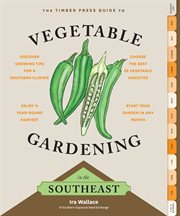Nonfiction
eBook
Details
PUBLISHED
Made available through hoopla
DESCRIPTION
1 online resource
ISBN/ISSN
LANGUAGE
NOTES
How to grow your own food in the Heartland! There is nothing more regionally specific than vegetable gardening-what to plant, when to plant it, and when to harvest are decisions based on climate, weather, and first frost The Timber Press Guide to Vegetable Gardening in the Southeast tackles this need head on, with regionally specific growing information written by local gardening expert, Ira Wallace. Monthly planting guides show exactly what you can do in the garden from January through December. The skill sets go beyond the basics with tutorials on seed saving, worm bins, and more. This must-have book is for gardeners in Alabama, Arkansas, Florida, Georgia, Kentucky, Louisiana, Maryland, Mississippi, North Carolina, South Carolina, Tennessee, Virginia, and West Virginia. This Timber Press Guide features an A-Z section that profiles the 50 vegetables, fruits, and herbs that grow best in the Southeast and provides basic care and maintenance for each. Ira Wallace serves on the board of the Organic Seed Alliance and is a worker/owner of the cooperatively managed Southern Exposure Seed Exchange, which offers over 700 varieties of open-pollinated heirloom and organic seeds selected for flavor and regional adaptability. She is also an organizer of the Heritage Harvest Festival at Monticello, a fun, family-friendly event featuring an old-time seed swap, local food, hands-on workshops, demos, and more. She currently writes about heirloom vegetable varieties for magazines and blogs including Mother Earth News, Fine Gardening, and Southern Exposure. Preface Vine-ripened tomatoes, succulent figs, crisp winter salads, corn on the cob, and sweet braised greens are just a few of the fresh-from-the-garden delights awaiting gardeners in the Southeast. Working with long, hot summers and mild, uneven winters, southern gardeners from Thomas Jefferson to Barbara Kingsolver have feasted abundantly in every season. Every year at the Heritage Harvest Festival at Monticello, a celebration of heirloom varieties, local food, and sustainable agriculture at Jefferson's mountaintop home, I have the privilege of meeting hundreds of eager gardeners. The bountiful harvest on display at the festival is an inspiration to new gardeners. With a little planning and knowing how to make the right choices for a southeastern garden, even beginning gardeners can have that abundance throughout the year. I often run workshops on year-round gardening and growing garlic and perennial onions at the Monticello and Mother Earth News fairs, and afterward, eager participants frequently ask if I have a book. Finally, this is my offering, sharing what I have learned about year-round food growing in over 40 years as an organic gardener and over 20 years as an advocate and producer of heirloom organic seeds at Southern Exposure Seed Exchange (SESE) in central Virginia. Our motto at SESE is "Saving the Past for the Future"; we strive to preserve the knowledge that lets farmers enjoy abundant harvests without chemical fertilizers and pesticides. Our farm is certified organic and I am committed to keeping our spot of earth healthy and productive. Throughout this book, I have shared the information you'll need to make your own garden equally rich. My gardening roots trace back to my grandmother's backyard in Florida where I grew up. We had something growing every month, although all I remember growing in late summer were black-eyed peas, okra, and sweet potatoes. That was the slow time, but it didn't last long. As soon as the weather started cooling off a little we went all out with greens, squash, peppers, tomatoes, and beans. Winter brought on lettuce, celery, and even more greens. I don't think I grew broccoli and other more refined members of the cabbage family until after I went off to college. But, boy, did we have som
Mode of access: World Wide Web







